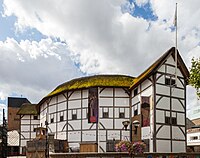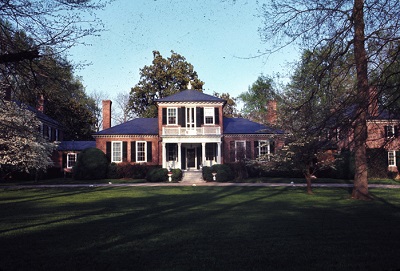William Shakespeare: Legendary Wordsmith, Globe Theatre; Va. Descendant Assn. Brandon
__________

- Shakespeare's Globe Theatre, London (Reconstruction)
Shakespeare's Globe is a reconstruction of the Globe Theatre, an Elizabethan playhouse for which William Shakespeare wrote his plays, in the London Borough of Southwark, on the south bank of the River Thames. The original theatre was built in 1599, destroyed by fire in 1613, rebuilt in 1614, and then demolished in 1644. The modern Globe Theatre is an academic approximation based on available evidence of the 1599 and 1614 buildings. It is considered quite realistic, though modern safety requirements mean that it holds only 1,400 spectators compared to the original theatre's 3,000.
Shakespeare's Globe was founded by the actor and director Sam Wanamaker, built about 230 metres (750 ft) from the site of the original theatre and opened to the public in 1997, with a production of Henry V. The site also includes the Sam Wanamaker Playhouse, an indoor theatre which opened in January 2014. This is a smaller, candle-lit space based on the indoor playhouses of Jacobean London..
https://en.wikipedia.org/wiki/Shakespeare%27s_Globe
________

- William Shakespeare; Brandon, Prince George County, Virginia, National Park Service (NPS)
Brandon is an historic plantation located on the south shore of the James River in Prince George County, Virginia. The plantation is located on 4,500 of the original 7,000 acres patented to Captain John Martin (1562-1632) in 1616. It is believed that the name Brandon came from the family name of Martin's wife, Mary Brandon. Martin was one of the original settlers to arrive in the New World. He served as a member of the first council for the Jamestown colony.
Brandon was inherited by Martin's grandson, Robert Bargrave, who sold it to Richard Quiney in 1635. Quiney's brother, Thomas, was married to Judith, William Shakespeare's daughter. Quiney and his descendants farmed Brandon until 1720, when it was sold to Nathaniel Harrison. Though Harrison never lied at Brandon, his son, Nathaniel Harrison II (1703-1791) decided to make the plantation his home. After Harrison II's death, Brandon was inherited by Colonel Benjamin Harrison (1743-1807).
After Harrison died, the plantation was divided between his two sons: William and George. Upper Brandon was given to William Byrd Harrison. William Harrison built his mansion in 1825 on 3,555 acres. Lower Brandon (aka Brandon Plantation) was given to George Evelyn Harrison who took over the original Brandon house.
Brandon remained in the Harrison family until 1926. Mr. and Mrs. Robert W. Daniel purchased the property and undertook the restoration of the house and grounds. Today, the house is furnished with 1760s English and American furniture. Sixteen hundred acres of the property are used for soybean, wheat, and barley cultivation. The agricultural activities, representing one of America's oldest continuous farming operations, are overseen by the Daniel's son, Robert...
https://www.nps.gov/articles/brandon.htm

